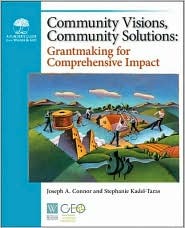
I think not.
Nor, it seems to me, can you achieve community outcomes with just the agencies, or schools, or hospitals, or funders, or whatever institutions in a community are dedicated to addressing "the problem," on board. For I'm a believer in the concept that a core requirement to true sustainable outcomes is a change in community expectations and behaviors. This can't be done by just a few committed souls. It is for this reason that I think of this work in the on-going (strategic v. tactical) sense of working differently. There are too many examples of strong, meaningful impact having an innoculation half life of two to three years (see my blog postings on The Cohort Effect and Return on Investment on Early Education for examples in the sphere of education outcomes). Impact needs to be embedded into the on-going community context -- not just grafted on as a transitory accomplishment. When we are envisioning community impact, we are required to think of the entire community -- skeptics and all.
Thus, engagement, full throated, cross-sector, friend and foe embrace is central to achieving collective impact. It should be the core capacity of any backbone or community support organization. But often the path of least resistance (see my review of Linchpin) sub-optimizes on the size of the circle. To get some help thinking about engagement, I went to Daniel H. Pink's new book "To Sell is Human" (which I'll review through a community collaborative lens in the near future).
In discussing engagement, Pink says that there are two methods of attempting to get people to act in a concerted way. The first, practiced in the vast majority of situations is IRRITATION. Here you are attempting to engage people to do something that WE want them to do. Think of the vast number of non-profit or corporate endeavors under the guise of engagement, community outreach, listening sessions, where in fact we are presenting the audience with something we have already decided to do and are seeking their assent.
According to Pink, the other, less traveled approach to engagement is AGITATION. Here you are engaging folks by challenging them to do something that THEY want to do. "Want to" creates much more energy than "have to."
This catalytic energy is one of the reasons why all of the Working Differently communities start at the aspirational level. In essence, coming to a shared aspiration brings us to a shared understanding of what it is we are collectively trying to achieve -- not in narrow provider or programatic language, but in clarity of what's in it for all of us. It brings the community to the necessary "want to" energy!
To be tweeted links to my new posts -- blog, book reviews (both nonfiction and fiction), data or other recommended tools -- either go to Twitter.com and follow me @jcrubicon, or just go to my Home page and click on the Twitter button on the right, just above the tweet stream, and follow me @jcrubicon.


 RSS Feed
RSS Feed
